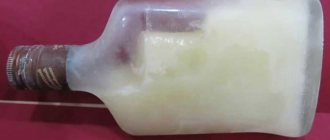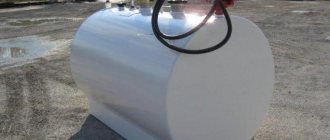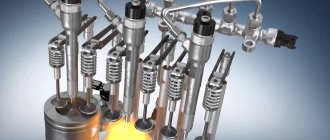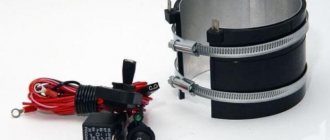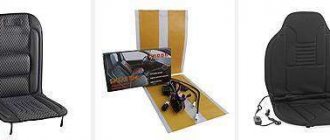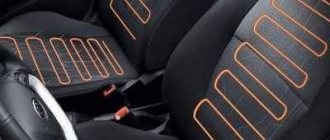Types of diesel fuel heaters in a standard tank: modern and vintage designs
While owners of gasoline versions set themselves the goal of how and with what to close the radiator without harming the engine, diesel drivers are mastering a course in electrical engineering. The value of this knowledge is exclusively applied: with it it is easier to create and install various heating designs. Antigel is not the best assistant on a long journey: in the cold it is powerless, it is much safer to travel with warm filters and a fuel intake.
Relevance of the idea
It makes sense for residents and guests of the northern regions to equip a diesel fuel tank heating system with their own hands. At forty-degree frosts, even paraffins fall out of the winter diesel fuel and the insulation of the filter is powerless: the intake will not be able to take at least a small fraction of the required portion due to the diesel fuel reaching its pour point.
An ordinary headlight bulb was previously regarded as the only way out of this situation. A sufficiently powerful thermal field from the lamp is able to melt the precipitated paraffins and ensure a flow of fuel into the coarse filter element, and there the fuel filter heater does its job. In a truck driver’s glove compartment, even now you can find a simple electrical circuit consisting of a light bulb, a fuse and a toggle switch - just in case.
Bandage patch
The bandage type of devices is made in the form of an overhead clip. It is intended for installation on the external part of the filter element and heating it before starting the power unit. For optimal operation, the device is connected to the vehicle’s on-board network, the voltage source being the battery.
Tape flexible
Such devices are intended for external thermal insulation and heating of fuel system elements. Flexible tape heaters effectively heat not only the body of the filter mechanism, but also the lines. Depending on the need, the devices can be heated either before starting the internal combustion engine or during engine operation.
Modern designs
A current way to protect the fuel system from sudden loss of performance in severe frost is a heated nozzle on the fuel intake. Those who are fond of solving problems using proprietary tools will benefit from developments from Nomakon:
- NTP 101/301 – for passenger cars (4,500/10,000 rubles).
- NTP 102/302 – for trucks (4,500/10,000 rubles).
Intakes with a tube diameter of 10/12 mm can be equipped with a primitive 101 or 102 model. 301 and 302 products are universal + trained to dynamically change heating power. The choice is made based on the maximum consumption of diesel fuel through the heater, the voltage of the on-board network and the design features of the intake element.
The design diagram is extremely simple. The heating element is built into a metal case and is controlled from the on-board network via a cabin button. When current is applied, the heater creates a local thermal field and warms up the diesel fuel around itself. The manufacturer already recommends equipping vehicles with such a system when operating at an average ambient temperature of -15°C.
Designs of flow heating of diesel fuel and their characteristics
An alternative to unit heating is flow-through heating of diesel fuel, the function of which, in contrast to a home-made cabin fan heater, is to increase the temperature of diesel fuel. Structurally, the idea is embodied in a small double-circuit block. The diesel fuel circulates along the internal circuit, the structure of the external circuit is determined by the type of coolant.
Liquid
Hot antifreeze is a natural source of heat. The easiest way to use this energy is to locally heat a small section of a pipeline with your own hands. The heater consists of two pipes of different diameters, one of which is located in the center of the other. The external circuit is an integral part of the cooling system; fuel passes through the internal circuit. The global implementation of such a system is hampered by a significant drawback - before starting the engine, the coolant is in a cold state. Essentially, the solution may be relevant in two cases:
- In harsh climatic conditions, as an alternative to tape heating of pipelines, so that diesel fuel does not lose fluidity during transportation.
- In midland regions, in the presence of pre-heating of the coolant.
Electrical
An electrical element with a high resistivity, through which a current of a certain strength is passed, is able to generate heat. This simple principle is taken as the basis for the manufacturing technology of electric heating. Progressive design:
- The direct function is executed immediately after the engine is started.
- There are prerequisites for automatic control of the operating temperature of diesel fuel.
Optimal layout
Flow heating of diesel fuel alone will not cope with dewaxing. Helpers needed. At the initial stage, a homemade fuel intake heater is sufficient. If you don’t want to make things yourself, ready-made factory products will help. Bandage heating of the filter is essentially unnecessary. According to the diesel fuel movement diagram, it is located behind the flow-through heater, therefore, warm diesel fuel splashes in the housing of the filter element and there is no need for an extraneous thermal field.
Artificial heating of the fuel line in the “intake-flow heater” section will not hurt. The line is long, and the local thermal field in the tank is not capable of significantly increasing the temperature of the fuel at the inlet to the fuel intake. Particular benefit from this accessory is felt in regions with harsh climatic conditions.
Heating of the coarse filter
The filter heating circuit can be implemented and diesel fuel fluidity can be ensured by the following modifications: the drain valve is replaced with a glow plug or the heating element is mounted in the body of the fitting through which fuel is supplied. In the process of implementing these schemes, you will need special equipment in the form of a lathe or contact specialists who can produce handicraft parts.
Please note that removing the drain valve will not allow you to subsequently remove excess water from the fuel supply system that may be present in the diesel fuel. You should resort to this heating method only if you are completely confident in the quality of the diesel fuel being filled.
To carry out the work, the coarse filter (separator) is removed. After this, you need to machine a sleeve from steel, which will act as a substitute for the drain cap. Next, a thread is cut to securely attach the element to the filter housing. After this, a hole is drilled in the bushing and an internal thread is cut with a tap, through which the stud will be attached.
Then the glow plug is screwed in, the positive wire is fed to the heating element, the negative wire is fed to the stud. The finished solution is screwed into the separator body. All work related to the implementation of the electrical circuit implies the same requirements that were put forward when creating heating of the fuel intake from the on-board network of a diesel vehicle.
There is also a simplified method for installing a glow plug, which does not require recessing individual additional elements. To install a glow plug in the valve fitting, you need to drill a hole, cut a thread in it and screw in the glow plug. The power supply is connected in the same way. It should be added that the second scheme is similar to factory solutions for heating diesel fuel.
How to make a 220V antifreeze heater
To ensure the circulation of refrigerant through the system when developing a 220 V automobile electric engine heater, it is best to use a pump. If there is no pumping device, heating equipment must be installed at the lowest point of the cooling system.
What will you need?
To develop an electric heater for a gasoline or diesel engine you will need:
Algorithm of actions
| Image | Step |
| At the first stage, it is necessary to improve the tank lid; to do this, glass is squeezed out of it. The required shape is cut out of a sheet of textolite (recommended thickness 6 mm), after which the material is glued into the lid using epoxy glue. This will ensure maximum tightness and prevent leakage. | |
| Then a heating component is glued into the lid using epoxy glue, in this case it is a heating element from an electric kettle | |
| The distribution mechanism is installed in such a way that the electrical wiring can be covered in it. Then a socket for connecting the conductor is installed in the lid of the box. | |
| The tank is fixed using clamps. One of the fastening elements will not allow the cover to fly off due to pressure when the power unit is running. | |
| A fitting with a valve is installed, which is used to bleed air from the tank |
Refinement of the fine filter
The fine filter loses its throughput even with a relatively small degree of paraffinization of diesel fuel. This does not allow the engine to start and can lead to malfunctions of the fuel injection pump, the fuel chamber of which is not supplied with fuel. Among the methods for heating diesel fuel with your own hands, heating this fine filter element stands out.
To make your own fine filter heater, you will need about 10 meters of copper wire, which has varnish insulation. You also need to have tools and materials for soldering (soldering iron, some tin and rosin), as well as insulating tape. Additionally, you will need to have a relay, a 10 or 15 A fuse, and a switch button.
Copper wire is wound in frequent turns around the body of the filter element. Contacts for supplying current are connected to its ends. The negative wire is supplied from the battery, a relay and a power button are installed on the positive one. It is optimal to make the positive contact from the ignition switch in order to avoid discharging the battery if the driver forgets to turn off the heating himself.
Flexible tape heaters
| 1 450 | |
| Tape heater 12/24V 1.5 meter | 1 650 |
| Tape heater 12V 2 meters | 1 950 |
| Tape heater 24V 2 meters | 1 950 |
| Tape heater 24V 3 meters | 2 250 |
| Tape heater 12V 4 meters | 2 450 |
| Tape heater 24V 4 meters | 2 450 |
| 12V wire kit | 1 650 |
| Set of wires 24V | 1 650 |
* Designed to heat fuel in the fuel line when the engine is running. Universal - can be installed on any type of car.
Fuel line heating
In severe frost, even diesel fuel heated in the tank can crystallize again during the rapid passage of fuel lines. It becomes possible to implement heating of diesel fuel yourself thanks to external insulation of the line. Insulation materials that are used in construction are suitable for this. It is also possible to install electric heating tape. Another method is a heat exchanger, which is placed directly in front of the entrance to the diesel fuel fine filter. To implement the task, it is necessary to perform welding work.
The heat exchanger is a double-circuit system, which consists of two tubes having different diameters. Next, you need to insert one tube into the other and center the thin tube in relation to the thicker one. Fuel will flow along the outer contour (thicker tube). For this purpose, special pipes are made in a large circuit. The inner tube is connected to the internal combustion engine cooling system in such a way that coolant enters it when moving in a small circle.
The complex of the above measures will ensure proper and stable fluidity of diesel fuel both at the time of starting a cold engine and during the further operation of the diesel vehicle during severe frosts.
“Turn the Engine” is dedicated to one of the greatest blessings of civilization - the piston internal combustion engine. Everything about the operation, service and preventative maintenance of gasoline and diesel internal combustion engines. Useful information on engine and attachment repairs, methods and techniques for carrying out diagnostic procedures. Tuning, engine tuning and competent selection of technical fluids.
Flow heat exchange: made easy
Even a mixture heated in a tank can easily freeze when traveling along a highway in severe frost, and even at high speeds. Flow-through heating of diesel fuel can be done with your own hands by first selecting the layout :
- simple insulation of the main line using construction materials;
- installation of an electrical tape device;
- installation in front of the fine fuel filter of the heat exchanger.
The last method is to create a part that has two independent contours. To do this, you need two tubes of different diameters. Welding centers the thinner part relative to the larger one. In the outer circuit there are inlet and outlet pipes for fuel. The indoor unit is connected to a small circle of the engine cooling system.
To achieve high reliability of winter start-up, comprehensive modernization should be carried out. It consists in the simultaneous application of all the above methods.
How to assemble a flow-through fuel heating and install it on a diesel engine with your own hands
We will focus our interest on the class of electric heaters. Liquid ones are often abandoned due to the inability to heat at the start and the lack of control over the temperature at the outlet of the device. Structures mounted on the output manifold have the same significant disadvantages.
Flow heating installation
The flow-through heater is built into the fuel line. This option will prevent the diesel fuel from freezing while driving. It is installed in front of the diesel fuel filter, or next to the tank. The effectiveness of this solution is less than that of the previous one. But when there is no alternative, flow heating is the only option. Rest assured that the diesel fuel will not freeze in the fuel line while driving.
Installation of heating diesel fuel in the tank
- an ideal winter option. And by using two types of heat conservation, you will forget about freezing the energy carrier.
Car owners will have to choose from two types of heaters. They can be placed together or separately. Cold resisters are reliable and simple. Rare models that had their own pump failed due to pressure in the fuel line.
When using heaters, do not forget about fire safety. An energy main and an electrical heating device can become an explosive tandem. Watch out for fuel leaks! This applies to both the installation procedure of heaters and further operation.
An important feature: the flow-through version starts together with the vehicle engine and, accordingly, receives energy from the generator. The pre-starter is powered by a battery, because it starts working before the engine starts.
Monitor the battery charge level! Installing a battery heater is as easy as shelling pears. If you are not sure, charge the battery before your next trip. This will protect you from additional problems.
Donor car
Some French and Korean diesel engines are equipped with flow-through fuel heating from the factory. Taking their standard design as a basis is an excellent solution. Regardless of the car manufacturer, the device configuration is standard, since it was developed by the same company - Delphi. However, it is not possible to find a part for sale using the original article number 9305-117B. According to the component codes of individual machines, the unit is available for purchase.
For your information. The comfortable temperature of diesel fuel at the inlet to the injection pump is 37-40°C. Starting from 52°C, the wear of pump parts accelerates significantly - the lubricating properties of the diesel engine are important for it, which deteriorate when overheated.
Solutions from specialized companies
For the consumer basket, universal heaters are always available from companies specializing exclusively in the production of heating means for diesel engines:
- Manual EPT-150S (NPP Platan), 12/24 V – 1,600 rubles.
- Manual Sever-S MiniMax (CFH 007), 12/24 V – 2,900 rubles.
- Manual Nomacon PP-101 (12 V)/PP-102 (24 V) – 4,700 rubles.
- Automatic Nomacon PP-201 (12V)/PP-202 (24V) – 6,800 rubles.
At the starting price, only EPT-150S can compete with standard flow-through heating of cold diesel fuel. The Russian model preheats in 5-10 minutes and starts working, providing a temperature difference between the inlet and outlet within 15...20 °C.
Unlike Delphi, the device can be installed on trucks: there are three configurations of connection fittings to choose from: diameters 8/10/12 mm. Disadvantage: manual control. It is based on a high-resource ceramic heating element.
Another closest competitor to Delphi, but in terms of functionality is Nomacon PP-201/PP-202. The Belarusian development is attractive due to its automatic mode: at a fuel temperature of +5°C, the automatic switches off the heating element. Passenger fitting – 9 mm, cargo fitting – 12 mm. The obvious downside is the price.
Methods for implementing electric heating
Experience shows that it is difficult to make a mid-flight electric heater at home - you need a powerful heating element of a specific configuration and reliable thermal insulation. It is no less difficult to satisfy the special requirements for the compactness of the device; it is much easier to use proprietary solutions.
Features of installing Delphi electric heating
Special recommendations for installing heating systems from specialized companies are given in full by them: on the technical side - a pipeline with two “quick connectors”, on the electrical side - no comments. The technical component of the installation of parts from Hyundai-Kia or Peugeot-Citroen is identical. The only recommendation is to look for a 10 mm hose in car catalogs and mount the unit.
For your information. Previously, a section of fuel line from SSANGYONG Rexton under article number 2277508420 fit well, but now it is difficult to find it on sale, and the price is high. Alternatively, ask at a showdown.
Complex electrical aspects of the installation of equipment from Delphi are observed in terms of searching for a special block. Both a plastic housing and contact elements are required. A comprehensive solution from Hyundai-Kia under code 8999900026AS will cost 1,100 rubles. Expensive. An alternative is auto disassembly or purchasing new components one by one:
- Block 6541.S9 – 300 rubles.
- 2 terminals 6541.E6 – 100 rubles.
Advice. The place where the wire is attached to the contact element is additionally soldered.
What is a fuel heater
The highlight of the operation of a diesel engine is the increase in fuel viscosity as the outside temperature drops.
Accordingly, diesel fuel, increasing its viscosity, passes through the fuel channels worse, becomes cloudy, crystallizes and can even completely freeze.
All these problems lead to the fact that the engine either starts poorly or does not start at all.
To minimize such problems, manufacturers install fuel heaters on diesel engines.
These are simple devices that are adapted for heating components made of different materials in the machine.
As a rule, each heater performs two functions:
- Warms up the fuel when the engine starts (such heaters are called pre-heaters).
- Maintains the required minimum heat during normal engine operation (this is a main type of heater).
Typical equipment of diesel passenger cars requires a 12 V battery, while on trucks more powerful 24 V devices are installed. The battery regulates the voltage in the entire power supply network, so for passenger cars and diesel trucks, heaters must be selected based on the power of the battery.
Cars are equipped with a 12 V battery.
We heat the fuel from the engine cooling system
A composition heated in a tank or separator can easily lose fluidity when passing along the entire highway, and even at high vehicle speeds. In this case, the car enthusiast can choose and make with his own hands any layout of the diesel fuel heater using simple technologies:
- basic insulation of the fuel line with building materials;
- installation of an electric flexible heater by winding or applying it to the surface of the unit;
- installation of a heat exchanger in front of the fine filter element.
The last method is to make a part that has two independent contours. The simplest example of such a device consists of two tubes of different diameters. The thinner tube is welded and centered inside the larger one. The outer circuit consists of pipes for passing diesel fuel. The small circle of the cooling system is connected to the indoor unit. Variations of this design are possible, where the circuits intended for diesel fuel and hot antifreeze can be swapped. More complex specimens contain an internal block made of a spiral type. High reliability of diesel starting in winter conditions can be ensured only with comprehensive modernization. Its essence lies in the use of several of the methods described above, which heat the components of the fuel system.
How to make heating of diesel fuel in a car tank with your own hands?
The mechanism that ensures the reliable supply of flammable liquid from the vehicle’s standard tank must be heated. You need to understand that in severe frosts, diesel fuel begins to lose fluidity already at the inlet of the fuel intake. Therefore, before starting the engine, it is necessary to preheat the fuel composition and ensure its working condition in cruising mode.
Vintage light bulb dipping method
In past times, when one could only dream of the current abundance of automotive accessories, diesel owners created a positive temperature field in the fuel tank using an ordinary 12 V light bulb with a power of 50-55 W. For this, in addition to the light source, we used:
- Electrical wires with a cross section of 2.5mm².
- Switch.
- Fuse.
The lamp is immersed through the neck of the tank directly into the fuel. Be sure to place it next to the fuel intake device. Only in this way will it be possible to effectively dissolve crystallized paraffin and ensure the stability of the flow of fuel into the pipeline. To prevent homemade heating of diesel fuel into the tank with your own hands from causing harm, a fuse must be included in the control circuit. Today this method looks archaic, but who knows what situation we might unexpectedly find ourselves in on a long journey? Perhaps this is how you can get out of an emergency situation when there is nothing suitable at hand.
Diesel fuel filter heater (bandage with button)
| 2 900 | |
| Filter heating 12V d=78-91 mm / h=52 mm (button) | 2 900 |
| Filter heating 12V d=90-105 mm h=82 mm (button) | 3 200 |
| Filter heating 24V d=73-86 mm / h=67 mm (button) | 4 300 |
| Filter heating 24V d=78-91 mm / h=52 mm (button) | 4 700 |
| Filter heating 24V d=90-105 h=82 mm (button) | 4 900 |
| Filter heating 24V d=117-125 h=80 mm (button) | 6 900 |
Diesel fuel filter heater (band with timer)
| 4 900 | |
| Filter heating 12V d=78-91 mm / h=52 mm (timer) | 4 900 |
| Filter heating 12V d=90-105 mm / h=82 mm (timer) | 5 900 |
* The pre-heater is designed to provide the necessary throughput of the fine filter by reducing the viscosity of the fuel and dissolving petroleum paraffins formed in it at subzero temperatures.
Wire heating
The option is more reliable and effective than the one described above. Based on its operating principle, it can be compared to the functioning of a heater that is built in to heat seats . The implementation scheme is simple and accessible to any car enthusiast:
- Make holes in the body of the intake mesh, up to 8-10 pieces on one side; they must be located opposite each other with a certain pitch offset.
- Prepare a special wire made from a material with high resistivity, for example, nichrome.
- Create a heating structure by threading the wire through the holes.
- Drill two holes in the intake cover to install the terminals and connect the wire to them.
- Connect the heating element to the vehicle's on-board network.
It is necessary to include a fuse in the electrical circuit, as well as a relay to automate the heating process.
Installing a heating device yourself
It is quite possible to install a bandage filter heater with your own hands. If we consider branded devices, they come with detailed installation instructions that take into account the specifics of specific models. We will consider a more “handicraft” installation option.
The filter is wrapped around a heating element, on top of which a heat-retaining material is placed. Next, the heater is connected to the car’s network according to the following diagram:
Connection diagram for bandage heater
The switch in the cabin is placed arbitrarily; the wires can be placed along any standard wiring line.
Do-it-yourself additional heating of a factory diesel fuel tank: step-by-step instructions
It is recommended to start making your own installation if you have a desire to invent something. There are no particular difficulties in the process of designing the product: no special skills are needed, but knowledge of electricity from a school physics course will not hurt - this is enough to correctly connect a homemade invention to the on-board network.
Components
You can construct a diesel fuel heater in a tank using available materials. The basis of the heating device is the heating element. It is unlikely that you will be able to find a heater for direct use - you will have to be smart. The following can serve as a converter of electric current into heat:
- Flexible heating element for 12 or 24 V.
- Nichrome wire.
- 12 V car boiler.
To connect to the electrical network, you will need a standard set of elements, consisting of a four-pin 30 A relay and a socket for it, a switch button, a 30 A fuse and a wire of the required length with a cross-section of at least 2.5 mm2. A visual indication of the heater operating modes, which is provided by an LED, will not be superfluous. Plastic ties and heat shrink casing should also be available.
For your information. A timer or thermal relay will help automate the control process.
Heating based on a boiler
Simplicity is the main criterion for the perfection of a homemade product. Using a car boiler as a heating element means taking the path of least resistance. In this situation, there is no need to invent anything - it is enough to purchase an accessory and the components necessary for assembling the electrical circuit at the auto store.
From the boiler itself, only a heater is needed - the plastic cover along with the cigarette lighter cord are removed. Further actions are carried out in accordance with the instructions:
- A hole is drilled in the fuel intake cover for the “+” terminal.
- The heating element is attached to the fuel intake using plastic ties.
- Wiring is connected to the boiler: ground goes to the nearest screw, “+” – from the interior. It is advisable to solder the twist and protect it with heat shrink.
- Seal the hole in the lid with sealant.
- Connect the “+” relay from the boiler, the button and the LED, ground. Take the positive contact from the battery through a 30 A fuse.
When installing a purchased or home-made fuel tank intake heating system on a diesel engine with your own hands, you encounter one problem area - the hole in the fuel intake cover. It is better to close it with some kind of plastic plug. Regular sealant and hot melt adhesive will not work: over time they will dissolve in diesel fuel. Liquid rubber has the required qualities: being in a liquid state, it completely clogs the technological hole and eventually turns into a solid state.
For your information. Liquid rubber is a one-component polyurethane sealant. Found on sale in small quantities. One example is Sikaflex-221.
Heater based on nichrome wire
The main characteristic of a nichrome product is resistivity. It depends on the geometric characteristics of the conductor: cross-section and length. The resistance value determines the power characteristics of the installation, which affect the amount of heat generated when a current of a certain strength passes.
When choosing electrical parameters, you can start from the same autoboiler. Its power does not exceed 200 W. This means the optimal resistance of a nichrome thread is 0.7 Ohm. Based on this value, the diameter and length of the nichrome conductor are selected using the resistance formula.
The installation part consists of installing a nichrome wire onto a special nozzle that fits onto the fuel intake. Most often, the plastic rim of the coarse mesh acts as the heater body. The connection of nichrome wire to a wire must be done mechanically - through a contact pair.
Diesel heating pad. What to choose to overcome the eternal nightmare of “tractor drivers”
This winter has once again confirmed that not every winter fuel that diesel cars are filled with at gas stations can rightfully be called winter. As soon as the thermometer dropped to -20°C and below, the joke became vital again, in which, in response to a request to fill the car with diesel fuel, a gas station operator asks: should you spread it on the filter or crumble it into the tank?
However, could it be otherwise if, for example, according to the information posted on the website of the Mozyr Oil Refinery, which offers three grades of winter diesel fuel, in the case of refueling with DT-Z-K5 grade F fuel, the normal operation of the diesel engine power system is guaranteed in frosts below -20° C is impossible due to the maximum filterability temperature of DT-Z-K5 grade F?
An alternative to grade F exists. This is diesel fuel DT-Z-K5 class 2 with a maximum filterability temperature of no higher than -32°C or DT-A-K5 class 4 with a maximum filterability temperature of up to -44°C. But we won’t look for the reason why not they, but grade F ended up in the tanks of cars that, during the peak Christmas frosts, experienced the main problem of winter diesel operation. We will look for a way to overcome the congenital or, if you like, production deficiency of the F variety, because severe cold will certainly not be the last time we have seen it.
The source of the problem is paraffin, which, like water, changes its state of aggregation with decreasing temperature, but unlike water, which turns into ice at zero degrees, paraffin begins to turn into a solid phase at -5°C. In this case, the fuel becomes cloudy, but as long as the size of the paraffin crystals remains smaller than the diameter of the pores in the filter paper of the fuel filter, there is nothing wrong with clouding - the fuel will pass through the filter.
However, with a further decrease in temperature, the paraffin particles grow and combine into flakes. As they move with the fuel, they clog the filter, settle on the fuel intake in the tank and in bottlenecks in the power system, preventing the circulation of fuel in the engine power system, which leads to the engine stopping.
However, the mechanism of diesel fuel paralysis has not been a secret for a long time, and ways to avoid it are also not new. For example, adding gasoline or kerosene to diesel fuel has been known since the times of the Soviet Union. When the “Iron Curtain” fell, after passenger diesel foreign cars, anti-gel additives for diesel fuel appeared on our market.
Kerosene, gasoline and anti-gels really help lower the temperature threshold of diesel fuel filterability, however, each of these methods of fighting for its pumpability through the power system also has disadvantages. When adding kerosene or gasoline, the lubricating properties of the fuel deteriorate, which can affect the service life of the rubbing parts of the fuel equipment. In addition, kerosene and gasoline reduce the cetane number, which determines the ability of diesel fuel to self-ignite. This affects cold starts, which are already worsening for diesel engines with the advent of frost, as well as an increase in the rigidity of the engine, which can affect the durability of the cylinder-piston parts.
The disadvantage of antigels is that they are difficult to use. The effect is achieved after physical and chemical processes with fuel, and they proceed normally only at temperatures above +5°C. Even if in cold weather all manipulations with the additive at a gas station are carried out very quickly, it is not a fact that a small amount of it, which should be added to the tank before refueling, will not have time to harden. This means that it is best to add antigel to a canister of fuel in a warm room, but not all owners of diesel cars allow their living conditions to do this.
Another way to prevent diesel fuel from freezing involves heating. Once the wax changes from a liquid to a solid state upon cooling, the fuel must be heated to temperatures at which it melts and remains liquid. But here’s the question: why do owners of cars equipped with standard filter heating also encounter a paraffin problem?
The disadvantage of standard designs is that many of them are liquid and connected to the engine cooling system. It takes some time for the antifreeze circulating through the standard heating to reach the desired temperature after starting the engine. The lower the ambient temperature, the longer this time. It happens that paraffin manages to clog the fuel filter and fuel intake in the tank before the standard filter heating and tank return heating have time to come to the rescue.
Some additional heaters, which can be purchased at retail or at service stations that specialize in their installation, are called pre-heaters for a reason. They are electrical devices connected to the vehicle’s on-board network, so when the engine is not running, the power source for their operation is the on-board battery, and after starting, the generator. Depending on the version, the heater can be controlled manually using a push-button switch or automatically using a switch with a timer.
In terms of ease of installation, efficiency and price, the bandage fuel filter heater is one of the most attractive. This heater is placed over the filter housing and secured with clamps. Hence, another advantage of the bandage device is that it provides thermal protection of the filter from hypothermia due to blowing with a flow of cold air while the car is moving.
Disadvantage: bandage heaters are only suitable for installation on filters with a metal body. The poorer thermal conductivity of plastic affects heat transfer and heat removal from the heater to the fuel, which creates a risk of overheating in the contact area between the device and the filter, which can cause the heater to fail, as well as deformation of the plastic filter housing.
Select a heater taking into account the height and diameter of the filter. In addition to size, the price is influenced by the type of control and the 12 or 24 V network voltage for which a particular model is designed. The cost of a manually controlled bandage device for ordinary passenger cars is 25-30 USD.
The disc heater is also designed to heat the fuel in the filter. Considering that it is installed only in filters that are threaded into the lids, and its heating surface area is smaller, it is not universal in terms of installation and is not as effective as a pre-start device as a bandage device. But after installation, the disk heater looks aesthetically pleasing and, due to the fact that its heating element is located directly in the fuel flow, it copes better with flow-through heating, which protects the fuel from freezing while the car is moving, than a band heater. Price - from 45 USD
Unfortunately, the disk heater, like the band heater, is not suitable for installation in filters with a plastic body. Due to the reduced power and lower surface temperature compared to bandage and disk heaters, flexible heaters, which are silicone tapes with sealed electrical leads, do not have this disadvantage. Belt pre-heaters are inferior in efficiency, but their versatility is superior, because in addition to filters, such devices can be passed along or wrapped around fuel lines, pipes and in general any parts that are desirable to heat, but are problematic or even impossible due to their complex shape or size . Tape heaters have a length from 1 to 4 m, are designed for a voltage of 12 or 24 V, the cost of such a meter-long heater is 35-40 USD.
Nozzles on fuel intakes can also be used as pre-heaters, but in this case the fuel is heated not in the filter, but in the fuel tank. Such heaters combine the functions of pre-launch and main heaters, that is, they provide fuel heating while the vehicle is moving.
There are several types of such devices. In the most complex ones, heating is combined: first, due to power from the on-board network, and then, after warming up the engine, using hot antifreeze from the cooling system, which enters and is discharged through tubes integrated into the design of the fuel intake. The simpler and more universal ones use only electric heating; they cost from 40 USD.
Unlike the heaters discussed above, flow-through designs are designed only to prevent fuel from freezing during a trip. Such heaters cut into the fuel line, most often directly in front of the fuel filter, and operate effectively only if there is a fuel flow in the line.
Again, depending on the type, the heater is controlled manually or using an electronic unit, which automatically turns on the heater when the fuel temperature is below +5°C and turns it off when this temperature is exceeded. The price of flow-through heaters is from 60 USD. and increases with automatic control.
And this is not all the devices that can help owners of diesel cars get rid of the threat of fuel freezing. Some of them can be purchased immediately at retail, others will have to be purchased on order. All that remains is to choose those that best take into account the design features of a particular machine and are most suitable for its operating conditions.
When it is required that the car drives every day and no matter what kind of frost comes to visit us, experts recommend solving the problem comprehensively by installing at least two heaters in the most vulnerable places of the power system. However, with this approach, it is also necessary to take into account the capabilities of on-board energy sources, as well as monitor their condition.
Sergey BOYARSKIKH Photos by the author and from open sources ABW.BY
Thank you for your help in preparing this article.
Improved fuel intake
To ensure a reliable supply of consistency from the tank in severe frosts, the mechanism must, of course, be heated, since diesel fuel begins to freeze already in the storage container. Before starting the internal combustion engine, it is necessary to warm up the train in advance and bring its capacity into working condition.
There are quite a few methods for creating a positive temperature field in a tank. Previously, a widespread method was to immerse a light bulb , with a power of about 55 W, directly into a container next to the fuel intake mechanism. The light source dissolved crystallized paraffin, which ensured stable fuel throughput.
Another option is do-it-yourself electric heating of diesel fuel , the operating principle of which is identical to the heater built into the seat. The embodiment is as follows:
- drill thin holes in the body of the intake mesh, located opposite each other with a certain offset in pitch (quantity - up to 5 pieces on one side);
- take a wire made of a material with high resistivity (for example, tin);
- form the structure of the heating element by passing plastic material through the holes;
- Connect the ends of the wire to the power supply network.
Worth remembering! When connecting any type of diesel fuel heater to the electrical network with your own hands, you should :
- integrate a fuse into the circuit;
- install a control button;
- install a relay to automate operation.
Fuel intake heating
Diesel fuel freezes already in the fuel tank. For this reason, preheating it when there is a big minus outside the window allows you to restore the fluidity of diesel fuel. You can raise the temperature in the fuel tank in different ways. One of the simplest is the solution to lower a regular 50-watt light bulb into the tank, which is located near the fuel intake. During operation, the light bulb heats up, the paraffin dissolves, and the system is able to pump diesel fuel.
The second way is to independently build an electric heating of diesel fuel with your own hands. Such heating will be similar in principle to a heating coil. To solve the problem you will need to get to the fuel intake grid. Then small diameter holes are drilled in the body at an equal distance from each other. It is recommended to make about 5 such holes on each side.
Please note that independent implementation of this electric heater circuit must be carried out taking into account the fact that the design must necessarily have a fuse. You will also need to equip the circuit with a special button to turn on the heating. An additional element is a relay for automatically turning off the current supply.
Next, you will need a wire whose material has high resistance. Tin wire works well for this task. The specified wire must be threaded through the prepared holes in the housing, creating a heater. The free ends will need to be connected to the power supply when finished.
Pre-heating installation
In cold weather, the fuel filter is the first to suffer, as diesel paraffins crystallize and clog it. It needs to be heated.
The most common option is a preheater. It is attached with clamps to the filter. The contacting aluminum side of the device is heated to 110°C. The filter warms up in a few minutes.
The price of preheaters directly depends on the dimensions and technical parameters. Manually operated devices cost $40-$50. Automatic systems are more expensive.
It is worth finding out in advance what the filter is made of. If the design contains plastic (French vehicle models are famous for this), then such a system will not work. The plastic becomes deformed when heated, and the filter may become inoperative.
Remember that the task of such a system is to warm up a portion of the flammable substance in the filter, which will serve to successfully start the engine.
Briefly about the main thing
The main reason for placing a diesel fuel heater in a car tank is to prevent diesel fuel from solidifying and becoming cloudy at the entrance to the fuel system. A secondary feature is the service life of the high-pressure pump: it is higher when working with warm diesel fuel.
You can invent a heating system based on a boiler, flexible heating element or nichrome wire. The optimal solution is a design based on an autoboiler. The cost of the accessory does not exceed 300 rubles, and the price of the branded offer from Nomakon starts from 4,500 rubles. The difference is noticeable, and independent work is not difficult.
Sources
- https://autodvig.com/toplivnaja-sistema/podogrevatel-toplivnogo-filtra-10883/
- https://autostadt.su/podogrev-toplivnogo-baka-na-dizel/
- https://KrutiMotor.ru/kak-podogret-diztoplivo/
- https://autoclub.su/podogrevatel-diztopliva/
- https://autostadt.su/protochnyi-podogrev-dlya-diztopliva/
- https://mashinapro.ru/471-podogrev-dizelnogo-topliva-v-bake.html
- https://autobann.su/kak-zdelat-protochnyi-podogrev-dizelnogo-topliva.html
- https://autostadt.su/podogrev-toplivnogo-filtra-dizelnogo-dvigatelya-svoimi-rukami/
- https://autoklimat.ru/ak/nomacon.html
Pros of having a heater
Firstly, the installed fuel heater does not require any chemical manipulations with the composition of the diesel fuel. It used to be very popular to add something flammable, but then they didn’t think about how this would affect the life of the engine and fuel equipment. It is also possible for excessive ignition pores to appear in the suction line of diesel engines. There is a very high probability that after one such winter, when you added gasoline to diesel, you will have to change the injectors and injection pump (high pressure fuel pump), and it is not at all necessary that cleaning will help.
We recommend: How to remove and unscrew the crankshaft pulley?
The fuel band heater acts on the weakest link of diesel engines, the fuel filter and all these so-called additives are simply not needed. The fuel heater can work in tandem with a second heater, i.e. bandage together with in-line, this combination will prevent the fuel from freezing on the road and will ensure easy engine starting. A fuel heater significantly increases engine efficiency. This is due to the fact that even if started in winter by some tricks, the engine will work unstably due to the fact that the diesel fuel will still remain thick and more fuel will be needed to ensure a normal mixture. This is very familiar to those who drive large trucks, like those with eighteen wheels. When the engine seems to be running, but the car cannot pull the truck or even stalls. While heated fuel moves better along the highway and contributes to high-quality mixture formation.
After reading all this, the question arises: why, in fact, are all diesel cars not equipped with heaters? The answer is simple: they are equipped, but not all. Basically, and this is logical, a fuel heater is installed on those cars that are pre-fitted for certain markets. Machines adapted for Russia, as a rule, have a heater. But this is usually not a bandage heater, but an in-line heater, so that the car does not freeze while driving, and starting it will be the owner’s problem. On the other hand, not all cars come to us already adapted. A large number of foreign cars that come to us on the secondary market from abroad come under their own power from various European countries, where the climate is much more benign than ours. There they rarely see severe frosts and they don’t need a fuel heater at all.
You can install a fuel heater on absolutely any car, even on an old diesel GAZ-24. At first, heaters became available for tractor-trailer drivers, since it was the worst thing for them to be left with a frozen car in the middle of the highway. But then these heaters worked more roughly, not like now, but that was a long time ago. Today, all the advantages of the heater are also appreciated by the owners of passenger cars. Now they don't have to get up early to get their swallow. Examples of cars that can be fitted with a fuel heater are Mitsubishi Padjero, Toyota Corolla and LandCruiser. As you can see, the cars are not cheap and difficult at all.
Diesel fuel heater
We recommend: Transmission oil service life
